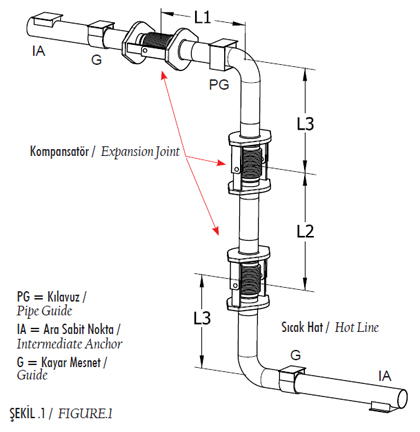KRS-34 Cardan Hinged-Welding End Angular expansion joints are the specific ones, absorbing the thermal expansion of the pipeline by transforming them to angular movements in a plane vertical to the axis. They may absorb the movements in one or more directions (in a plane vertical to the axis of the pipe). The assemblies consisting of two or more lateral expansion joints may absorb big amounts of expansions..

Bellow Features
Standard Production : AISI 321 (DIN 1.4541)
Special Production : AISI 304 (DIN 1.4541), AISI 309 (DIN 1.4828), AISI 316 (DIN 1.4401), AISI 316 ti (DIN 1.4571) etc
Design Information :
Design Pressure : 16 BAR
Design Temperature : – 196 + 550 C
Hinge Features :
Standard Hinge : Rst 37-2 (DIN 1.0038)
PN 2,5, PN6, PN10, PN16
Special Hinge : Stainless Steel etc.
Flange-Neck Features :
Standard Flange-Neck : Rst 37-2 (DIN 1.0038)
Special Flange-Neck : Stainless Steel DIN, BS, EN, ANSI etc.
Applications
For absorbing angular movement, All machines, All pumps, All motors, Industrial applications, Exhaust systems, Gas and water lines, Drinking water lines, etc.
Painting Information
All flanges, hinges and pipes are between DN25-DN500 are with special paint ( for corrossion protection).
Special Note
Design temperature can be designed until + 950 C as well.Products are under our 2 years quarantee for factory faults. For special requirements please consult us. Please see Useful technical tables pages for flange and pipe size tables.Use liner to protect bellow from wear due to abrasive media.


What Is Angular Movement ?

The movements resulting fromangulations of the expansion joints with respect to their axes are called angular movements. As it can be seen in the figure, thermal expansion in both the horizontal and vertical legs can be absorbed by using hinged expansion joints. Following points should be taken into consideration by locating expansion joints to such piping systems:
1. The distances L1 and L2 should be made the maximum possible,
2. The distance L3 should be made the minimum possible.
In order to keep offset and frictional forces affecting the expansion joints and anchors small, the hinges should be designed in the way to compensate the pressure thrust and weight of the pipe between the two expansion joints.


